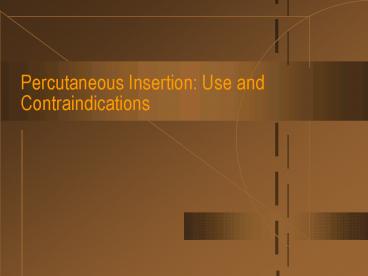Percutaneous Insertion: Use and Contraindications PowerPoint PPT Presentation
1 / 22
Title: Percutaneous Insertion: Use and Contraindications
1
Percutaneous Insertion Use and Contraindications
2
Background
- Drive towards minimal invasive surgery
- Advancement in endovascular techniques and
technology - Expanding indications
- Development of endoluminal stenting
- early studies indicate less blood loss, shorter
lengths of stay in ICU and in hospital
3
Percutaneous Access
- 1) reduce patient discomfort
- 2) reduce time to ambulation
- 3) reduce time to discharge
- 4) allow earlier return to normal activities
- 5) reduce local complications
4
Percutaneous Access
- limited by sheath size
- endoluminal stenting 14-24F
- carotid/subclavian stenting 7-10F
- can be achieved by
- smaller device profiles
- closure devices
5
Percutaneous Access Haemostasis
- Affected by
- 1) Patient factors
- age
- weight
- comorbid conditions - hypertension,
coagulopathies - 2) Procedural factors
- use of anticoagulation
- sheath sizes
- puncture site
6
Access site Complications
- Coronary catheterisation
- diagnostic angiogram 0.5-1.5
- balloon angioplasty 1-3
- coronary stenting 5-17
- open incision endoluminal stenting 13-14
- wound seroma and infection
- bleeding
- dissection and distal emboli
7
Closure Devices Types
- Extravascular
- implantable collagen plug (Vasoseal)
- collagen/thrombin injection (Duett)
- Intravascular
- bio-absorbable haemostatic anchor (Angio-Seal)
- percutaneous suture device (Prostar XL and Closer)
8
Closure Devices
9
Perclose Prostar XL
- Perclose Australia
10
Perclose Prostar XL
- Perclose Australia
11
Perclose Prostar XL
- Advantages
- secure haemostasis
- large bore/ anticoagulation, high punctures
- minimal compression
- patient comfort and mobility
- Disadvantages
- high costs
- steep learning curve (Loubeyre C, et al J Am Coll
Cardiol 1997) - 9 complication
- 2.1 surgical rate
- gt250 cases/user
- closure related complications
12
Device Related Complications
- persistent bleeding
- pseudoaneurysm
- infection
- arterial/venous occlusion
- arterial dissection
- arteriovenous fistula
- distal embolism
13
Closure Devices
- Sprouse, L.R. et al J Vasc Surg 2001
- retrospective review of patients requiring
vascular surgery admission with (n11) and
without (n14) use of closure devices - pseudoaneurysm are larger and do not respond to
ultrasound compression - complications result in more blood loss and
increased need for transfusions - infections are more common and require aggressive
surgery
14
Prostar for endoluminal stenting
- Preclose method (Haas, P. Et al. 1999)
- limited (1cm) incision
- subcutaneous tract dilatation
- needles deployed prior to endoluminal stent
- sutures tied at end of procedure
15
Prostar Endoluminal Trials
16
Perth Prostar Experience
- Methods
- 82 percutaneous closures in 44 patients
- 10F Prostar XL PVS device
- 1 iliac, 1 thoracic and 42 abdominal aortic
aneurysms - 2 devices for main body and 1 for contralateral
limb - product specialist present
17
Perth Prostar Experience
18
Perth Prostar Experience
- Results
- 85 success rate, 12 failures requiring surgery
- 1 death related to a myocardial infarction
precipitated by a retroperitoneal bleed - device introduction - unable to advance device
- needle deployment - needle deflection
- closure of arteriotomy - bleeding(7),
obstruction(1) - late complication - psuedoaneurysm (1)
19
Lessons
- patient selection
- obesity (5)
- scarred groin (1)
- preoperative ilio-femoral assessment
- tortuous iliac artery (2)
- high CFA bifurcation (2)
- calcified artery
- CT scanning/on-table ultrasound
20
Lessons
- high puncture
- 1 mortality - unrecognised bleeding
- suture management
- suture catching (1)
- keep sutures wet, ensure free running
- guide wire
- not a true over the wire system
- angulated proximal neck
21
Developments
- X-Site PFC (Blue Pell, PA)
- lower cost alternative to Perclose
- SuperStitch (Sutura, Inc)
- suture mediated device for up to 24F
22
Conclusion
- Open groin dissection remains the standard
- Careful patient selection
- Tutorlage and experience
- Surgical skills to recognise and deal with
complications

